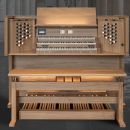Leeuwarden Jacobijnerkerk
Undoubtedly, the most significant interior piece of the Great Church is the organ that has filled the entire west wall of the church since 1727. On March 19, 1727, the new instrument was inspected by several skilled organists on behalf of the city authorities. They submitted a very favorable report on March 25, marking the beginning of the organ's fame, which continues to this day!
The current organ was built in the years 1724-1727 by an organ builder from Amsterdam originally hailing from the Harz region in Germany, Christian Müller. On June 2, 1724, the organist of the Great Church, Rynoldus Popma van Oevering, was instructed to "thoroughly inquire in Holland about the newest types and models of organs, and the best masters to make them, as well as their prices."
Müller get the job
Popma van Oevering then came into contact with Christian Müller in Amsterdam, who already enjoyed a certain reputation. On July 21, this organ builder came to Leeuwarden to further negotiate with the committee appointed by the city authorities. Müller brought a drawing with him, and the contract was signed on July 28. The organ would consist of 3 manuals (keyboards) and a separate pedalboard for the feet. The instrument would have 37 stops. Müller also had to repair the old organ and transfer it to the Westerkerk. He would receive 9000 guilders for all of this.

Leeuwarden Jacobijnerkerk
Specifications
General
- Müller, 1727
- 3 keyboards
- 38 stops





























